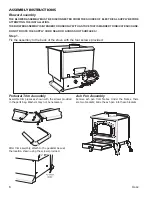
JINECO02 RevG 11/06/12
To burn wood, push the operating tool up and
away from you.
When left in this position, air is restricted
through the bed of the fire providing a solid
base to build up a bed of ash.
Surplus ash can be removed either by gentle
riddling or with a shovel.
It might prove beneficial when burning more
reactive fuels to leave the grate in a “neutral”
position, thus directing some under fire air and
some over fire air to the firebed.
Notes on Wood burning
With a full load of wood, the stove will need to
be refuelled approximately once every hour.
Wood can be stacked in the stove, but care
must be taken that logs do not touch the baffle.
Overloading the stove can cause excess smoke
to be emitted.
Wood burns most efficiently with the secondary
air valve lever in the open position and the
primary control closed. Moving the secondary
control will control the burn rate of the stove.
Note - primary and secondary air is needed to
light the stove, see section entitled ‘Lighting the
Stove’
Wood burns best on a bed of ash and it is
therefore only necessary to remove surplus ash
from the stove occasionally.
Refuelling must be carried out with a sufficient
quantity of glowing embers and ash, so that the
new fuel charge will ignite quickly. If there are
too few embers, add some kindling to prevent
excessive smoke.
Lighting the Stove
We recommend that you have two or three
small fires before you operate your stove to its
maximum heat output.
This is to allow the paint to cure in steadily and
to give a long service life of the paint finish.
During this curing in process you may notice an
unpleasant smell. It is non-toxic, but for your
comfort we would suggest that during this
period you leave all doors and windows open.
To light the stove open the primary and
secondary air controls by pushing both levers
fully to the right. Light one or two firelighters
placed centrally on the grate, allowing the
flames to become established before placing
several pieces of small dry kindling in a criss-
cross fashion above the firelighters, taking care
not to smother the fire. Close the stove door.
Once the kindling is well alight open the door
and build the fire by gradually adding slightly
larger pieces of wood, closing the door
afterwards.
Once you have a good fire established across
the grate bed, further fuel can be added as
required and the air controls set to the correct
position (see ‘Notes on Wood burning’).
Should the fire fail to light correctly open the
door and use a poker to spread the fuel across
the grate. Close the door and allow the fuel and
stove to cool before attempting to relight the
fire.
N.B. Leaving the air controls in the closed
position, adding too much fuel or using wood
that is wet or too large will prevent the fire
from establishing correctly and may result in
smoke emission from the stove.


































